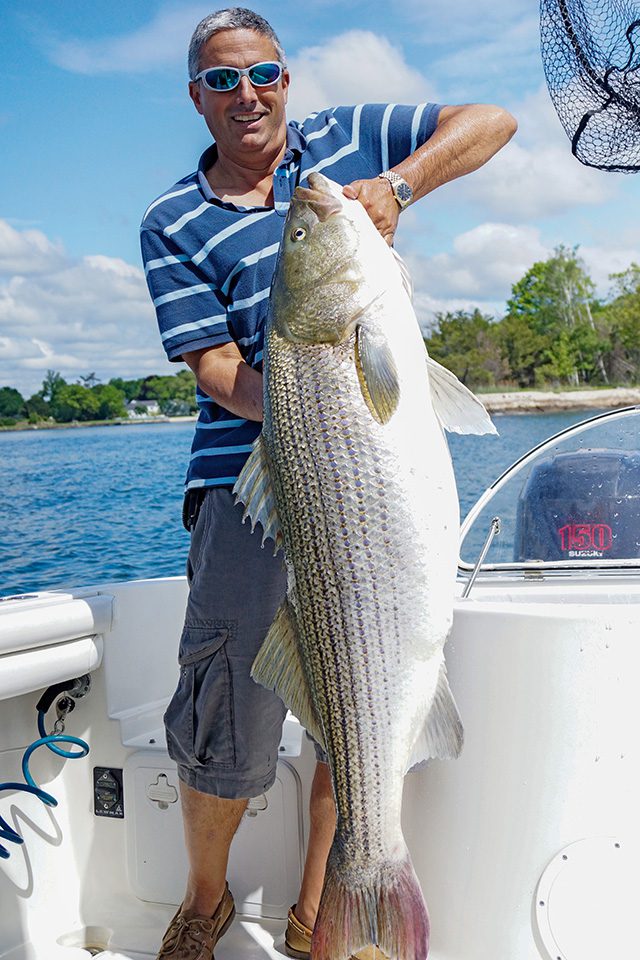Options Laid Out to Replenish the Stock
From the Massachusetts Division of Marine Fisheries:
In early summer of 2023, the Massachusetts Division of Marine Fisheries and all the fisheries agencies from North Carolina to Maine implemented, through an Atlantic States Marine Fisheries Commission emergency action, a major change in the slot size for striped bass caught recreationally in the ocean along the Atlantic coast. The slot size was reduced from 28”-35” to 28”-31”. This significant, some would say draconian, measure was in response to an almost doubling of recreational harvest in 2022 and also to protect the large 2015 year class. As difficult as this decision was, it was necessary to slow down the harvest in order to stay on track with rebuilding the striped bass stock. As we turn the page on 2023, the question is: where do we go from here regarding striped bass management?
Analyses subsequent to the emergency reduction of the slot limit indicate that a 14.5 percent reduction in total coastwide removals (or 16% recreational reduction if no cut is applied to the commercial fishery) in 2024 is needed to maintain the trajectory of increasing spawning stock biomass (SSB) with a target date of 2029 for full recovery. The ASMFC Striped Bass Management Board initiated Addendum II to address this necessary cut in removals.
Draft Addendum II includes separate options for the Chesapeake Bay recreational fishery, the ocean recreational fishery and the commercial fishery. For the ocean recreational fishery, maintaining the 28” – 31” slot in 2024 will accomplish the required cut. Additional options include a 30”-33” slot and for applying separate rules to the private/shore anglers and the for-hire fleet (specifically, a wider slot limit of 28”-33” for the for-hire fleet). For the Chesapeake Bay recreational fishery, a variety of slot sizes are proposed that would be applied uniformly throughout the Bay (currently there are differences in regulations among the Bay jurisdictions). The Addendum also contains options for the Bay recreational fishery to have more liberal rules for the for-hire fleet in comparison to the private/shore anglers (specifically, a 2-fish limit instead of 1-fish limit). For the commercial fishery, the Addendum has an option to reduce the ocean and Chesapeake Bay commercial quotas by up to 14.5 percent.
The Addendum also contains options to establish minimum requirements for states that allow filleting at sea in the recreational fishery, such as the retention of the rack after filleting, and to define whether a charter captain and mate(s) are subject to for-hire rules or private/shore rules when on a charter (this is only applicable if separate rules are adopted for the two sectors). Finally, the Addendum has an option to bypass the normal rule making process to implement rules more quickly should the next stock assessment (available next fall) show the need for additional conservation to keep us on track with rebuilding the SSB.
Public hearings on Draft Addendum II were held in November and December. The public comments are being tabulated and will be presented to the Board at the ASMFC Winter Meeting (January 23-25, 2024). During that meeting, the Board will choose among the options and the states will then be required to implement the selected rules through their individual rule-making processes.
On another but related note, the Board received some grim news at the October meeting: the Maryland striped bass young-of-year index for 2023 was the second lowest in the 66-year time series. Unfortunately, this joins the prior four years (2019-2022) in being well-below average. These five poor year classes are not the result of inadequate management or overfishing but rather the product of environmental conditions on the spawning grounds in the tributaries of the Chesapeake Bay. These year classes will make it very difficult to maintain the SSB at the desired level when these fish enter the reproducing population (beginning in about 2026). The challenge will be to maintain the fishing mortality at a very low level while these poor year classes pass through the fisheries. While the trajectory of SSB in a few years is uncertain, it is likely that preserving SSB in the coming years may be the greatest challenge that the Striped Bass Board has had in decades.
Where can management go next when such restrictive harvest measures are already in place? The recreational catch and release fishery is expected to remain the largest source of fishing mortality on the stock. This underscores the importance of the Division’s ongoing studies into the factors that influence the survival of striped bass after they are released. Anglers can contribute to our understanding by being a part of our second year of the Striped Bass Citizen Science Project in 2024.
